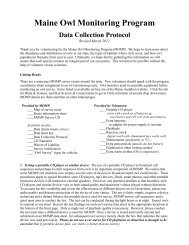Focus Species Forestry - Maine Audubon
Focus Species Forestry - Maine Audubon
Focus Species Forestry - Maine Audubon
Create successful ePaper yourself
Turn your PDF publications into a flip-book with our unique Google optimized e-Paper software.
<strong>Focus</strong> <strong>Species</strong> and Human Values<br />
While biology helped the advisory committee define a long list of potential focus species, the<br />
values that humans place on forest wildlife helped shorten the list. <strong>Species</strong> important to humans<br />
include:<br />
• Flagship species: “popular” species<br />
that help promote public support for<br />
conservation efforts. Examples from<br />
<strong>Maine</strong> might include the American<br />
marten, a symbol of the northern forest,<br />
or brook trout, which symbolizes<br />
<strong>Maine</strong>’s cool, clear rivers and streams.<br />
• Economically important species:<br />
species that are important to the<br />
economy, such as fish and game or<br />
“watchable wildlife” such as moose.<br />
• Easy-to-identify species: species that<br />
are easily recognized by sight<br />
(including tracks) or sound with<br />
minimal training. An ideal suite of<br />
focus species will include several that<br />
are year-round residents.<br />
Protecting habitat for popular and economically important<br />
species such as the brook trout benefits local communities and<br />
the many species that live in or near forest streams.<br />
Selecting species that humans enjoy helps build support for focus species management. In<br />
addition, several relatively obscure species or species groups were selected to represent<br />
important habitats that are less well known. These include the redback salamander, an abundant<br />
but seldom seen inhabitant of the forest leaf litter, and lichens that are found in late-successional<br />
forests.<br />
<strong>Focus</strong> <strong>Species</strong>, Forest Ecosystems, and Natural Communities<br />
The <strong>Maine</strong> Natural Areas Program classifies forests, wetlands, grasslands, and other habitat<br />
types into a system of 98 natural communities that occur in 24 broader ecosystem types. There<br />
are about 24 natural communities associated with commercial timberlands.<br />
A natural community is an assemblage of interacting plants and animals and their<br />
common environment where the effects of human intervention are minimal (Gawler<br />
2001).<br />
Natural communities are usually identified by their dominant vegetation, although in some forest<br />
ecosystem types, such as spruce-fir, geographic location, soils, and understory vegetation are<br />
also used.<br />
<strong>Focus</strong> <strong>Species</strong> <strong>Forestry</strong> 5



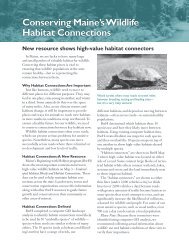
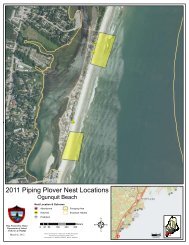
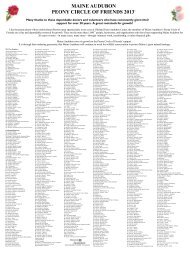
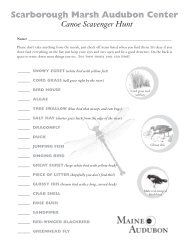


![2012 Loon Count Results [pdf] - Maine Audubon](https://img.yumpu.com/26228732/1/190x245/2012-loon-count-results-pdf-maine-audubon.jpg?quality=85)
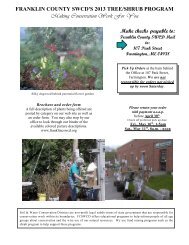
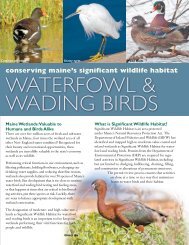
![Lake Fish of Maine (DIFW list) [pdf] - Maine Audubon](https://img.yumpu.com/23282964/1/190x245/lake-fish-of-maine-difw-list-pdf-maine-audubon.jpg?quality=85)
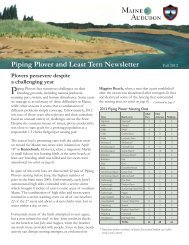

![The Maine Audubon Peony Circle of Friends 2012 [pdf]](https://img.yumpu.com/22707677/1/190x253/the-maine-audubon-peony-circle-of-friends-2012-pdf.jpg?quality=85)
